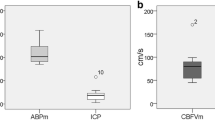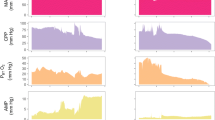Abstract
Introduction: Cerebral critical closing pressure (CrCP) comprises intracranial pressure (ICP) and arteriolar wall tension (WT). It is the arterial blood pressure (ABP) at which small vessels close and circulation stops. We hypothesized that the increase in WT secondary to a systemic hypertensive challenge would lead to an increase in CrCP and that the “effective” cerebral perfusion pressure (CPPeff; calculated as ABP − CrCP) would give more complete information than the “conventional” cerebral perfusion pressure (CPP; calculated as ABP − ICP).
Objective: This study aimed to compare CrCP, CPP, and CPPeff changes during a hypertensive challenge in patients with a severe traumatic brain injury.
Patients and Methods: Data on ABP, ICP, and cerebral blood flow velocity, measured by transcranial Doppler ultrasound, were acquired simultaneously for 30 min both basally and during a hypertensive challenge. An impedance-based CrCP model was used.
Results: The following values are expressed as median (interquartile range). There were 11 patients, aged 29 (14) years. CPP increased from 73 (17) to 102 (26) mmHg (P ≤ 0.001). ICP did not change. CrCP changed from 23 (11) to 27 (10) mmHg (P ≤ 0.001). WT increased from 7 (5) to 11 (7) mmHg (P ˂ 0.005). CPPeff changed less than CPP.
Conclusion: The CPP change was greater than the CPPeff change, mainly because CrCP increased simultaneously with the WT increase as a result of the autoregulatory response. CPPeff provides information about the real driving force generating blood movement.
Access this chapter
Tax calculation will be finalised at checkout
Purchases are for personal use only
Similar content being viewed by others
References
Aaslid R, Lash SR, Bardy GH, Gild WH, Newell DW (2003) Dynamic pressure—flow velocity relationships in the human cerebral circulation. Stroke 34:1645–1649
Czosnyka M, Smielewski P, Piechnik S, Al-Rawi PG, Kirkpatrick PJ, Matta BF, Pickard JD (1999) Critical closing pressure in cerebrovascular circulation. J Neurol Neurosurg Psychiatry 66:606–611
Panerai RB (2003) The critical closing pressure of the cerebral circulation. Med Eng Phys 25:621–632
Varsos GV, de Riva N, Smielewski P, Pickard JD, Brady KM, Reinhard M, Avolio A, Czosnyka M (2013) Critical closing pressure during intracranial pressure plateau waves. Neurocrit Care 18:341–348
Varsos GV, Richards HK, Kasprowicz M, Reinhard M, Smielewski P, Brady KM, Pickard JD, Czosnyka M (2014) Cessation of diastolic cerebral blood flow velocity: the role of critical closing pressure. Neurocrit Care 20:40–48
Gomez H, Camacho J, Yelicich B, Moraes L, Biestro A, Puppo C (2010) Development of a multimodal monitoring platform for medical research. Presented at the 2010 Annual International Conference of the IEEE Engineering in Medicine and Biology, Buenos Aires, 31 Aug to 4 Sep 2010. https://doi.org/10.1109/IEMBS.2010.5627936
Aaslid R, Markwalder TM, Nornes H (1982) Noninvasive transcranial Doppler ultrasound recording of flow velocity in basal cerebral arteries. J Neurosurg 57:769–774
Puppo C, Camacho J, Varsos GV, Yelicich B, Gómez H, Moraes L, Biestro A, Czosnyka M (2016) Cerebral critical closing pressure: is the multiparameter model better suited to estimate physiology of cerebral hemodynamics? Neurocrit Care 25:446–454
Puppo C, Camacho J, Yelicich B, Moraes L, Biestro A, Gomez H (2012) Bedside study of cerebral critical closing pressure in patients with severe traumatic brain injury: a transcranial Doppler study. Acta Neurochir Suppl 114:283–288
Varsos GV, Richards H, Kasprowicz M, Budohoski KP, Brady KM, Reinhard M, Avolio A, Smielewski P, Pickard JD, Czosnyka M (2013) Critical closing pressure determined with a model of cerebrovascular impedance. J Cereb Blood Flow Metab 33:235–243
Soehle M, Czosnyka M, Pickard JD, Kirkpatrick PJ (2004) Critical closing pressure in subarachnoid hemorrhage: effect of cerebral vasospasm and limitations of a transcranial Doppler–derived estimation. Stroke 35:1393–1398
Thees C, Scholz M, Schaller MDC, Gass A, Pavlidis C, Weyland A, Hoeft A (2002) Relationship between intracranial pressure and critical closing pressure in patients with neurotrauma. Anesthesiology 96:595–599
van den Brule JMD, Stolk R, Vinke EJ, van Loon LM, Pickkers P, van der Hoeven JG, Kox M, Hoedemaekers CWE (2018) Vasopressors do not influence cerebral critical closing pressure during systemic inflammation evoked by experimental endotoxemia and sepsis in humans. Shock 49:529–535
Varsos GV, Budohoski KP, Czosnyka M, Kolias AG, Nasr N, Donnelly J, Liu X, Kim DJ, Hutchinson PJ, Kirkpatrick PJ, Varsos VG, Smielewski P (2015) Cerebral vasospasm affects arterial critical closing pressure. J Cereb Blood Flow Metab 35:285–291
Kaczmarska K, Kasprowicz M, Uryga A, Calviello L, Varsos G, Czosnyka Z, Czosnyka M (2018) Critical closing pressure during controlled increase in intracranial pressure—comparison of three methods. IEEE Trans Biomed Eng 65:619–624
Varsos GV, Czosnyka M, Smielewski P, Garnett MR, Liu X, Adams H, Pickard JD, Czosnyka Z (2016) Cerebral critical closing pressure during infusion tests. Acta Neurochir Suppl 122:215–220
Smielewski P, Steiner L, Puppo C, Budohoski K, Varsos GV, Czosnyka M (2018) Effect of mild hypocapnia on critical closing pressure and other mechanoelastic parameters of the cerebrospinal system. Acta Neurochir Suppl 126:139–142
Gazzoli P, Frigerio M, De Peri E, Rasulo F, Gasparotti R, Lavinio A, Latronico N (2006) A case of negative critical closing pressure. Abstracts of the 8th International Conference on Xenon CT and Related Cerebral Blood Flow Techniques: cerebral blood flow and brain metabolic imaging in clinical practice. Br J Neurosurg 20:348
Kasprowicz M, Diedler J, Reinhard M, Carrera E, Smielewski P, Budohoski KP, Sorrentino E, Haubrich C, Kirkpatrick PJ, Pickard JD, Czosnyka M (2012) Time constant of the cerebral arterial bed. Acta Neurochir Suppl 114:17–21
Puppo C, Kasprowicz M, Steiner LA, Yelicich B, Lalou DA, Smielewski P, Czosnyka M (2020) Hypocapnia after traumatic brain injury: how does it affect the time constant of the cerebral circulation? J Clin Monit Comput 34:461–468
Jägersberg M, Schaller C, Boström J, Schatlo B, Kotowski M, Thees C (2010) Simultaneous bedside assessment of global cerebral blood flow and effective cerebral perfusion pressure in patients with intracranial hypertension. Neurocrit Care 12:225–233
Author information
Authors and Affiliations
Editor information
Editors and Affiliations
Ethics declarations
This trial (the data acquisition phase) was funded through research initiation funding to one of the authors (Leandro Moraes) by the Universidad de la Republica Comision Sectorial de Investigación Científica (CSIC) (University Scientific Research Sectorial Commission). The other authors do not have any conflict of interest to declare.
Rights and permissions
Copyright information
© 2021 Springer Nature Switzerland AG
About this chapter
Cite this chapter
Moraes, L., Yelicich, B., Noble, M., Biestro, A., Puppo, C. (2021). Impacts of a Pressure Challenge on Cerebral Critical Closing Pressure and Effective Cerebral Perfusion Pressure in Patients with Traumatic Brain Injury. In: Depreitere, B., Meyfroidt, G., Güiza, F. (eds) Intracranial Pressure and Neuromonitoring XVII. Acta Neurochirurgica Supplement, vol 131. Springer, Cham. https://doi.org/10.1007/978-3-030-59436-7_3
Download citation
DOI: https://doi.org/10.1007/978-3-030-59436-7_3
Published:
Publisher Name: Springer, Cham
Print ISBN: 978-3-030-59435-0
Online ISBN: 978-3-030-59436-7
eBook Packages: MedicineMedicine (R0)




